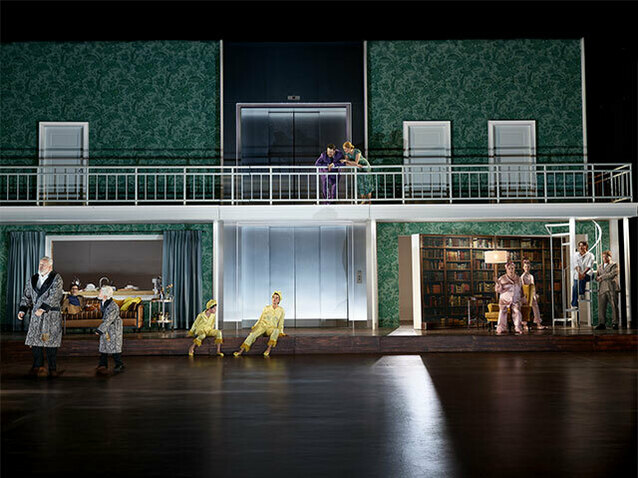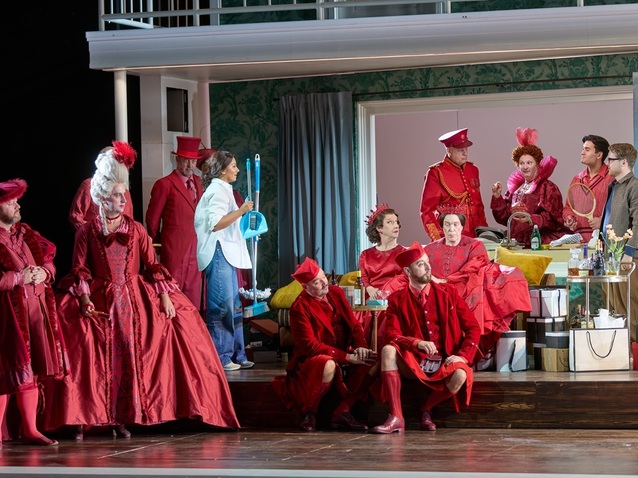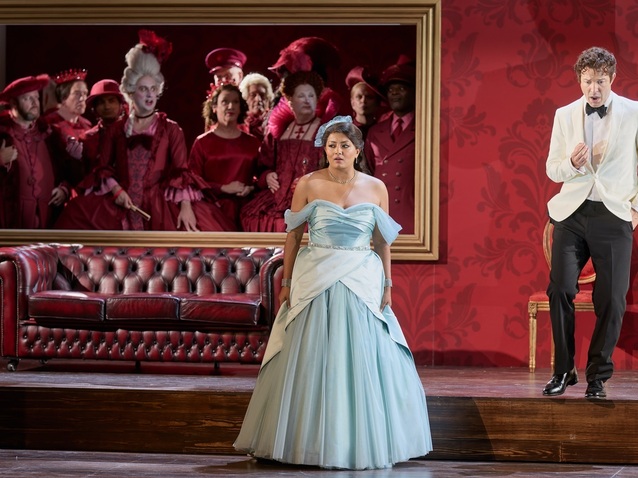 © Mark Douet
© Mark Douet
Gioacchino Rossini’s La Cenerentola, performed here in English as Cinderella, is based on the traditional fairytale. While many versions of it exist, the one that is most widely known in the English speaking world was published in French as Cendrillon by Charles Perrault in his Histoires ou contes du temps passé in 1697. Unlike Perrault’s version, however, Rossini’s steers clear of the more supernatural elements, and many have argued that this reflects the composer’s own preference for focusing the story on human nature and character. The truth, however, is either more prosaic or more fascinating depending on one’s point of view.
Rossini and his librettist Jacopo Ferretti had only weeks to deliver their opera in 1817, and so to save time they worked closely from a model that already existed. This was Nicolò Isouard’s Cendrillon of 1810, with a libretto by Charles Guillaume Étienne, and the similarities are plain to see. The heroine may be called Angelina in Rossini’s version (she has no title other than Cendrillon in Isouard’s), but the names of the characters Clorinda, Tisbe, Ramiro, Dandini and Alidoro all come directly from the earlier creation. Like Isouard’s version, the wicked stepmother is replaced by a stepfather, Don Magnifico, and the Fairy Godmother by Alidoro, a philosopher and tutor to the Prince. Unlike it, however, Cinderella is identified by a silver bracelet rather than a glass slipper.
Cendrillon had been immensely popular at the Palais Garnier when it premiered in 1810, and every performance there over the following three years had seen a massive demand for tickets. The fact that La Cenerentola was then to eclipse it so completely proves just how highly acclaimed Rossini’s version was, because it was hardly beating third rate ‘opposition’.

Deepa Johnny, Aaron Godfrey-Mayes, Chorus of ENO, ENO’s Cinderella (La Cenerentola) 2025 © Mark Douet
Julia Burbach’s new production for English National Opera moves the action forward to the present day. When Alidoro arrives at Don Magnifico’s home towards the start bearing gifts he is dressed not unlike a Deliveroo rider. The ending has the feel of a modern day celebrity wedding with red carpets, lavish dresses and everyone surrounded by photographers and the paparazzi.
Don Magnifico’s home may look as if it comes from the second half of the twentieth century, but this reflects the fact that everything is out of date because he has run out of money. In Herbert Murauer’s set his house stands on two levels and is entered by a lift. On the one hand, this suggests his home is actually an apartment, but the feature’s significance goes far beyond the literal. It allows for clear entrances and exits, and for a fantasy world to be entered as characters swirl into it and Cinderella and the Prince enjoy a moment alone inside. The same basic set is then transformed into the Prince’s palace in an ingenious manner that sees the dominant colour change from green to red.
If the general ambience of Don Magnifico’s home gives the tale the slight feel of a domestic drama, it is still one that carries the complete weight of (in this instance) English history on its shoulders. This is because the chorus who are normally all courtiers become the Prince’s ancestors. We can specifically make out the figures of Henry VIII, Elizabeth I, Charles II and Victoria, as well as Scottish monarchs and more recent Kings whose interests lay in polo, tennis and golf. All are played by men because the chorus only comprises tenors and basses, and they are first introduced to us as their portraits in a picture gallery. The fact they are all dressed in red, courtesy of costume designer Sussie Juhlin-Wallén, gives them an otherworldly feel, and while it is normally the courtiers who tell the Prince it is his duty to continue the bloodline by finding a wife, here his very ancestors order him to do so.
If the staging is generally sound, the overall impression it leaves is let down by a few things that make it feel unbalanced. The first main scene feels too cluttered for us really to focus on the two sisters Clorinda and Tisbe, while, until we reach the very end of the ball, that scene feels too empty as the Prince’s ancestors and other guests are shunted to the back or behind walls. While there are moments when time freezes as Cinderella and the Prince’s eyes meet, they only have real impact if there has been mass activity up until then.

Deepa Johnny, Charles Rice, Chorus of ENO, ENO’s Cinderella (La Cenerentola) 2025 © Mark Douet
The modern setting is offset by the introduction of a few more ‘magical’ elements such as Alidoro being supported in his endeavours by a troupe of mice, played by children. They are a lovely touch in their own right, but one wonders whether, had the opera been presented in a more traditional form to begin with, there would have been less sense of the various elements pulling in different directions. Similarly, during the Overture we see both Cinderella and the Prince’s childhoods, which shows the similarities and differences between them, and reveals her mother and father before their deaths. After this, however, the mother remains as too frequent a silent presence throughout the opera while Clorinda and Tisbe as children, who also appear during the Overture, are completely absent until just before the end. Late on we also see a ‘young’ version of Don Magnifico (although still with white hair and a beard!), which is amusing. However, it breaks the connection between Don Magnifico and the audience in ‘Sia qualunque delle figlie’, which here is moved towards the end of the opera, as he addresses half of the aria to us and half to his younger self.
Yi-Chen Lin’s conducting is rigorous and effective, while the cast can be divided between those who are good and those who really stand out. David Ireland arguably tops the list as his superb bass-baritone combines with strong stage presence to deliver a very compelling performance. Simon Bailey is a class act as Don Magnifico as his penchant for comic timing and delivery of ‘Intendente? Direttor?’ are masterly. As Dandini, Charles Rice reveals quite an expansive baritone, and the right level of flamboyance, as he pretends to be the Prince.
In the title role Deepa Johnny reveals a persuasive mezzo-soprano that possesses some quite subtle hues, and is taken to another level when it matters. Aaron Godfrey-Mayes asserts his tenor to good effect as he gives a convincing portrayal of a Prince for whom outward show is far less important than what lies beneath. Finally, Isabelle Peters and Grace Durham really go to town on playing the ghastly sisters Clorinda and Tisbe, with Durham also revealing her versatility as she played the part of Cinderella for Nevill Holt Opera in 2023.
By Sam Smith
Cinderella | 27 September - 14 October 2025 | London Coliseum
the 30 of September, 2025 | Print
Comments